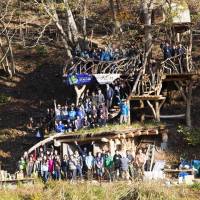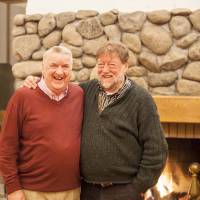Fifty-one years have rushed by since I first spent a winter in Japan, and 33 years since I first spent a Christmas and New Year in Kurohime, northern Nagano Prefecture. We got our first snows in early November, but at the time of writing, although the mountain peaks are dusted with white, the snow around the house has gone. Locals, including me, think the coming winter will be a severe one.
Autumn colors in this part of the world are spectacular. Mosquitoes, horseflies and midges vanish, ladybugs and stinky scarab beetles scurry and squeeze into any nook or cranny they can find. The last leaves detach themselves from their twigs and branches, pirouette and fall. Larch needles sweep down in golden brown showers. Dried brown beech leaves rattle and shake on their trees, stubbornly hanging on. Little birds come down from the mountains. Migrants appear and depart. We make sure we have enough firewood. I stock up the freezer with another year's supply of venison and wild boar. It's a special time of year and I appreciate the beauty, yet for me there is always a deep and lingering sadness, a shadowy loneliness.
Not for one minute do I regret coming to Japan, spending most of my life here and taking Japanese citizenship, but when it comes to Christmas, well, it's a lonely time of year. After all, Christmas is not really a thing in Japan, despite the lights, jingle-bell and silent-night songs, gaudy trees in hotel lobbies and so-called Christmas creamy sponge cakes.
Like so many other expatriates from Europe or North America, I try to re-create a family Christmas. I will hang decorations, cook, wash dishes, carry firewood, serve drinks and so on, but I will definitely not work on Christmas Day. This is not so for my Japanese and for several of my expatriate friends. Japanese children, if it is a weekday, even go to school on Christmas Day!
I have a worldwide scattering of grown-up children, five grandchildren, nephews, nieces and cousins, but only my younger brother survives the rest of my immediate family. I was 10 when he was born, and absolutely delighted to have him arrive. It is to my deep regret that I didn't spend much time with him when he was growing up. I was off on my first arctic expedition when he was 7, then again to a second expedition when he was 8. When he was 10 he and my mother waved me off on my third long, over-wintering expedition, at the end of which I came to Japan in 1962. I never saw my mother again. It was 16 years later that I finally visited Britain and saw my little brother, now a grown man with a family.
We exchanged letters and cards, and I missed him very much. When in Ethiopia I tried to get him to join me in the Simien Mountains, but my parents wouldn't hear of it. Despite all this, ever since Elwyn was 26 and I 36, despite the geographical distances that usually separate us, we've been as close as brothers can be.
Elwyn brought his wife and young family to spend Christmas and New Year here at this house for the first time in 1983. I have been back to spend the season in Wales and England for three times since then.
Now, as the patriarch of the Nicol clan, it is my responsibility to make a warm and welcoming Christmas just in case any of the family or close friends need to share this festive time.
Elwyn and his wife Susan won't be in Japan at Christmas — after all they have families back home — but they both came to visit me here in Kurohime on Nov. 4. It was not the time, I decided, to roast a turkey, but as it was a very special occasion, I prepared a roasted haunch of Hokkaido venison, enough to give the 40 guests, woodland trust members and their families and close local friends, generous second helpings should they so desire. We held the party in the main hall of our woodland trust center. Every morsel of venison, along with the gravy, cranberry jelly and horseradish sauce, not to mention the roast potatoes and other trimmings, were devoured.
I have heard and read some very foolish and ill-informed bumf on venison here in Japan, mostly from folk who try to be posh and who call all wild and natural meats gibier (which I thought was the Japanese for local craft beer). These misinformed folk usually think that the only way to cook venison is to marinate it in cheap red wine and serve it with a thick sauce. Here in Kurohime I serve very little beef, especially not that unhealthy marbled fatty crap from Kobe, created for people with neither taste nor teeth.
As we entertain many guests, we consume four to five whole adult deer per year. From one average adult Sika deer I can serve about 100 meals. From the larger Ezo or Hokkaido deer I can serve an average of 120 meals. My guests range from conservative older Japanese to young folk and children, as well as many international friends and visitors with widely varying customs and food preferences. So far, only the handful of vegetarians have turned down my venison, but I don't mind because we have plenty of grass and other growing stuff that they can go out and munch on.
Fellow cooks, please allow me to explain how I can handle such a big hunk of meat in what would be a normally sized family gas oven in the West.
If the meat has been preserved frozen, as much of ours is, I give it three or four days to gradually thaw out, carefully wrapped in soft muslin cloth and airtight plastic packaging. Even if I haven't skinned and butchered the animal myself, I always get venison complete with bones. A rump and back leg will not fit into the kind of lidded roasting pan used to cook turkey; in fact, the rump and hind legs of an Ezo deer will not fit into my oven. Therefore I de-bone the meat. I also remove any deer fat because it is too waxy. This white fat is saved to get the fires going in our big brick and stone fireplace.
I wipe any blood off the thawed meat then rub coarse black pepper and good sea salt into the incisions from where the big bones were cut out. Into this I also pack large pats of butter. The whole joint is tied up with string, and pepper and salt are rubbed onto the outside. Once in the roasting pan, the joint is gently basted with olive oil.
The venison joint is cooked in the oven for an hour at 170 degrees C, then taken out for a basting. By this time a lot of rich gravy has accumulated in the pan. With the lid back on, the haunch is returned to the oven for another hour at the same temperature, then taken out, basted again then left to rest for about half an hour out of the oven with the lid on while the roast potatoes get nicely browned.
The haunch in the roasting pan then goes back into the oven, lid off and well basted with the temperature raised to 250 degrees. At this crucial point one large glass of red wine goes into the cook and another over the roast. The joint is then frequently basted for about 30 minutes until browned and a bit crisp on the outside. When carved the meat should be a bit pink on the inside, juicy and tender, and certainly not "smelly." With some sherry or wine, herbs and a little thickening, the juices in the pan will make gravy.
Elwyn and Susan were in Kurohime for three days, then departed to tour Japan while I was off to do more lectures and meetings. We were supposed to meet up together in Tokyo for a night out on the town on Nov. 16, a night that would surely have gone down in legend, but I was informed that 40 or more volunteers from all over Asia, including China, Taiwan, Vietnam and Myanmar, were expecting me to give a welcoming lecture in Higashi Matsushima, then to spend the rest of the day working at trimming out dense bamboo grass undergrowth in the destined forest school woods.
My brother understood, so it was OK, but I was torn between missing him and enjoying the company and enthusiasm of our Asian friends, mostly new, although a few had already visited us in Kurohime. Taking part in a different culture and making new friends is always good, but as with many other expatriates, wherever you may be, there are times when you miss family roots.
I think I'll roast a turkey and a haunch of venison this Christmas — that is, if I can't get hold of a nice, fat goose.



















With your current subscription plan you can comment on stories. However, before writing your first comment, please create a display name in the Profile section of your subscriber account page.